 advertisements advertisements
|

|
Thomas Stafford, astronaut who led Apollo-Soyuz mission, dies at 93
March 18, 2024 — Former NASA astronaut Thomas Stafford, who flew to the moon before leading the first international space mission carried out by the United States and Russia, has died at the age of 93.
Stafford's death on Monday (March 18) came after an extended illness, according to Max Ary, director of the Stafford Air and Space Museum in Oklahoma.
"This nation has lost one of its great heroes," said Ary in a call with collectSPACE. "We are so shocked and saddened by his passing. It's just hard to say because he was bigger than life."
A member of NASA's second class of astronauts selected in 1962, Stafford made four flights into space. His contributions to space exploration continued far beyond his career as an astronaut, up until the time of his death.
"Today General Tom Stafford went to the eternal heavens which he so courageously explored as a Gemini and Apollo astronaut as well as a peacemaker in Apollo-Soyuz. Those of us privileged to know him are very sad but grateful we knew a giant," said Bill Nelson, NASA Administrator, in a statement.
Two for two
Stafford's first flight assignment was canceled while he and Gemini 6 mission commander Walter "Wally" Schirra were sitting on the launch pad. Set to lift off on Oct. 25, 1965, the two astronauts were tasked with performing a rendezvous with the upper stage of an Atlas-Agena rocket, but their target never reached orbit.
"We could hear it thunder off down the pad," said Stafford in a 1997 NASA oral history interview. "When the Agena lifted off, they had made some changes to have an oxidizer fuel lead-in change, and it did it wrong, and the thing lifted off and blew [up] over the Atlantic Ocean."
NASA managers quickly made new plans to launch Schirra and Stafford on an alternate Gemini 6A mission to rendezvous with the Gemini 7 spacecraft crewed by Frank Borman and Jim Lovell.
"We'd never done that before, had two spacecraft go," said Stafford.
This time, Stafford narrowly missed a second scrub and a possibly much worse outcome.
On Dec. 12, 1965, eight days after the Gemini 7 crew had made it into orbit, the Titan II rocket carrying Schirra and Stafford ignited its twin nozzle LR87 engine and then, 1.5 seconds later, shut down. Mission rules stated that the astronauts should have ejected from the capsule, but sensing no movement, Schirra decided not to abort.
His quick thinking not only saved Gemini 6A launch vehicle, which successfully lifted off just three days later, but also may have spared his and Stafford's lives.
"It turns out ... had we had [ejected, we] would have been two Roman candles going out, because we were [in] 15 or 16 psi pure oxygen, soaking in that for an hour and a half," Stafford said. "With that fire going off like that, it would have burned [our] suits."
Fortunately, the two were safe and on Dec. 15, 1965, the Gemini 6A spacecraft met the Gemini 7 spacecraft for the first rendezvous in space. Though they did not dock, but the two capsules came within a foot (30 centimeters) of each other.
"We flew in formation there for several hours ... and got within a couple inches of them," said Stafford.
Stafford and Schirra returned to Earth the next day, splashing down in the North Atlantic Ocean where they were recovered by the USS Wasp aircraft carrier.
Five months later, Stafford's second mission began almost just like his first, with the failed launch of an Agena target vehicle. NASA had learned from its earlier errors, though, and had an alternate ready to go, the Augmented Target Docking Adapter (ATDA), built from the reentry control section of a Gemini.
The Gemini 9A mission launched on June 3, 1966, with Stafford as commander and Gene Cernan as pilot.
Stafford flew a successful rendezvous with the ATDA, but as he and Cernan first approached the target, it became clear that it was tumbling and its fairing had not been jettisoned.
"We got up close [and] I could see this weird thing," said Stafford. "I came right up close to it, and it just broke out in sunrise, and here was the shroud. I called it the "angry alligator" [as] it looked just like that. And it was slowly rotating."
The shroud's "jaws" prevented Gemini 9A from docking and proposals by both engineers on the ground and the astronauts aboard the spacecraft to remedy the situation were called off out of concern that attempting to free the straps holding the shroud in place could pose a harm to the crew. Instead, Stafford and Cernan moved on to their second goal: an extravehicular activity (EVA) or spacewalk.
"So [Cernan was] supposed to out for about two hours and 30-some minutes, go take this rocket pack and get into it and fly it around and maneuver around," said Stafford, referring to the Air Force's experimental Astronaut Maneuvering Unit (AMU). "So he goes out in front and does a few little maneuvers and he's having a very difficult time. There was nothing for him to hold on to."
Cernan's problems continued to mount. His back hurt due to the rigidity of his suit, he was overheating in the direct sunlight and then his visor fogged up to the point he could no longer see. As a result, Stafford made the decision to call off the AMU test and end the EVA.
"I said [to Mission Control], 'Look, I've called it off. He's fogged over, he can't see. We've semi-lost one way of two-way com. [He's] not going to fly the rocket pack.' My main thing was to get him in before the next sunset, so we got all squared away and he got in," said Stafford.
The Gemini 9A crew returned to Earth the next day, landing on June 6, 1966, to again be recovered by the USS Wasp.
Snoopy to the moon
Three years later, on May 18, 1969, Stafford, Cernan and John Young launched together on a "dress rehearsal" for the first moon landing.
Led by Stafford as the mission's commander, the Apollo 10 astronauts were only the second crew in history fly to the moon. Once in lunar orbit, Stafford and Cernan moved into the lunar module "Snoopy" and closed the hatch on Young, who remained inside the command module "Charlie Brown."
Stafford was at Snoopy's controls as he and Cernan came within just 7.8 miles (14.4 kilometers) of the moon's surface, the point at which a powered descent for a touchdown would begin on the landing mission to follow.
It could have taken just the flip of a couple of switches for Stafford and Cernan to become the first humans on the moon.
"They wanted me to," said Stafford of the possibility of conducting a landing on Apollo 10, "but first we looked at the weight. I had a heavy-weight lunar module, number one, and number two, they also didn't have the software all worked out for that power descent. So, there's no way I could have done it."
Even without touching down, Stafford and Cernan were afforded a tremendous view of the moon.
"What always amazed me was the size of the boulders," said Stafford. "They were awesome, these big ones, you know, huge things. Some of them are pure white with black striations up on the side of these gigantic craters. I said, 'Oh, they would have to be as big as a two- or three-story building. It's hard to judge distance.'"
"It turns out those things are bigger than the Astrodome, those boulders. I mean, they were awesome pieces of mass," he said.
On the way back to dock with Charlie Brown, Stafford and Cernan briefly lost control of Snoopy due to a misconfigured switch for the abort guidance system.
"The whole damned spacecraft started to tumble and tried to rotate," Stafford said. "I just reached over and blew off the descent stage, because all the thrusters were on the ascent stage, [to] get better torque-to-inertia ratio."
Ultimately, it took just about 20 seconds for Stafford to regain control of the lunar module, and he resumed their approach to the command module. In total, Apollo 10 spent more than 61 hours orbiting the moon, eight while Charlie Brown and Snoopy were separated.
Returning to Earth on May 26, 1969, Stafford, Cernan and Young achieved a maximum velocity of 24,791 miles per hour (39,897 kilometers per hour), a record that still stands for the fastest speed at which any humans have travelled.
Natural extension
Stafford's fourth and final spaceflight was as the U.S. crew commander of the Apollo-Soyuz Test Project (ASTP), the first joint mission flown by the United States and Russia (then the Soviet Union). The mission included the launch of a Russian Soyuz spacecraft with two cosmonauts aboard and an Apollo command module with a specially-built docking adapter and three NASA astronauts.
On July 17, 1975, the two vehicles came together in Earth orbit.
"Capture!" announced Stafford.
"Soyuz and Apollo are shaking hands now," said Alexei Leonov, commander of the Soviet crew.
For two days, the two crews — including Stafford, Leonov, Deke Slayton, Vance Brand and Valery Kubasov — worked as one, exchanging handshakes and hugs, sharing meals, presenting ceremonial gifts and receiving congratulatory messages from their respective countries' leaders.
The ASTP mission laid the early groundwork for the once-Cold War and space race rivals to collaborate on the International Space Station, including the U.S. space shuttle missions that docked with the Russian space station Mir and then the birth of the orbiting outpost 25 years ago.
"I think it was a natural follow-on," said Stafford of the Apollo-Soyuz Test Project. "We'd flown Apollo. That was finished. Skylab had been terminated ... and the Russians were still going. So it was a natural extension."
Thomas Patten Stafford
Thomas Patten Stafford was born on Sept. 17, 1930, in Weatherford, Oklahoma. He earned a Bachelor of Science degree from the U.S. Naval Academy in 1952.
Stafford received his pilot wings at Connally Air Force Base in Waco, Texas, in 1953. He then completed advanced interceptor training and was assigned to the 54th Flight Interceptor Squadron at Ellsworth Air Force Base in Rapid City, South Dakota. In December 1955, he was assigned to the 496th Fighter Interceptor Squadron at Hahn Air Base in Germany, where he performed the duties of pilot, flight leader and flight test maintenance office, flying F-86Ds.
Stafford attended the U.S. Air Force Experimental Test Pilot School and then was an instructor in flight test training and specialized academic subjects — establishing basic textbooks and directing the writing of flight test manuals for use by the staff and students.
Before being assigned to Gemini 6, Stafford served as the backup pilot for Gemini 3, the first crewed mission of the two-seat spacecraft. He later served as the backup commander for Apollo 7, the first crewed launch of the command module.
Between his flights on Gemini 9A and Apollo 10, from August 1966 to October 1968, Stafford headed the mission planning analysis and software development responsibilities for the astronaut group for Project Apollo. As the lead member of the group, he helped formulate the sequence of missions that led to the first lunar landing mission.
As astronaut project manager, Stafford demonstrated and implemented the theory of a pilot manually flying the Saturn V booster into orbit and the translunar injection maneuver.
Stafford was assigned as chief of the astronaut office in June 1969, making him responsible for the selection of flight crews for projects Apollo and Skylab. He reviewed and monitored flight crew training status reports and was responsible for the coordination, scheduling and control of all activities involving NASA astronauts.
In June 1971, Stafford was assigned as deputy director of flight crew operations at the NASA Manned Spacecraft Center (today, Johnson Space Center) in Houston. Stafford was responsible for assisting the director in planning and implementation of programs for the astronaut group, the aircraft operations, flight crew integration, flight crew procedures and crew simulation and training divisions.
Stafford retired from NASA on Nov. 1, 1975 and three days later assumed command of the U.S. Air Force Flight Test Center at Edwards Air Force Base in California. On May 1, 1978, he became the deputy chief of staff for research, development and acquisition at U.S. Air Force headquarters in Washington, DC.
It was during this time that Stafford initiated the F-117A stealth fighter. In 1979, he wrote the initial desired specifications on and started the advanced technology bomber ATB development, now designated as the B-2 "stealth bomber." He also initiated the AGM-129 Stealth Cruise missile.
Stafford retired from the Air Force in November 1979 with the rank of lieutenant general. He served on several corporate boards, including OMEGA Watches and Gulfstream Aerospace, as well as founded his own consulting firm.
In 1990, at the invitation of the White House, he began serving on panels shaping the future direction of NASA's human spaceflight programs.
He chaired the Synthesis Committee, establishing a plan for lunar and Mars missions, and led the group overseeing the first Hubble Space Telescope servicing mission. He worked as an advisor on Space Station Freedom, the precursor to the International Space Station, and consulted on the Shuttle-Mir program and its series of joint missions. Stafford also co-chaired the task group working to return the shuttle to flight after the loss of the STS-107 crew aboard Columbia in 2003.
At the time of his death, Stafford was chairman of the NASA Advisory Council Task Force for ISS Safety and Operational Readiness.
For his service to the U.S. space program, Stafford was awarded the NASA Distinguished Service Medal, the NASA Exceptional Service Medal, the Harmon International Aviation Trophy, the Society of Experimental Test Pilots James H. Doolittle Award, the Congressional Space Medal of Honor and the Russian Medal "For Merit in Space Exploration," among many other honors.
In 1969, Stafford and his Apollo 10 crewmates were awarded the Special Trustees Award by the National Academy of Television Arts and Sciences for the first color television broadcast from space. Stafford was inducted into the National Aviation Hall of Fame, the Oklahoma Aviation and Space Hall of Fame, the International Air and Space Hall of Fame, the U.S. Astronaut Hall of Fame and International Space Hall of Fame.
In 2004, NASA named Stafford an Ambassador of Exploration and awarded him (in name only) a moon rock, which in 2005 he placed on display at the Stafford Air and Space Museum in Weatherford.
In addition to the museum, which opened in 1993, the airport and a building at Southwestern Oklahoma State University in Weatherford are named in Stafford's honor, as is the Stafford Building at the Federal Aviation Administration (FAA) Mike Monroney Aeronautical Center in Oklahoma City. Stafford was the recipient of honorary doctorate degrees from Oklahoma City University in Oklahoma, Western State University in California, Emerson College in Massachusetts and Embry-Riddle Aeronautical University in Florida.
In 2002, Stafford published his memoirs, "We Have Capture," written with Michael Cassutt. In 1998, Stafford was portrayed by actor Steve Hofvendahl in the HBO miniseries "From the Earth to the Moon."
Stafford is preceded in death by his Gemini 6A crewmate Wally Schirra, his Gemini 9A and Apollo 10 crewmate Gene Cernan, his Apollo 10 crewmate John Young and his Apollo-Soyuz Test Project crewmates Deke Slayton, Alexei Leonov and Valery Kubasov.
In 1953, Stafford was married to Faye Shoemaker, with whom he had two daughters, Dionne Kay and Karin Elain. They were divorced in 1985 (Shoemaker died in 2009) and Stafford later married Linda Ann Dishman in 1998. They adopted two sons, Michael Thomas and Stanislav "Stas" Patten. Dishman also has has two children from a prior marriage, Kassie Neering and Mark Hill. |
|
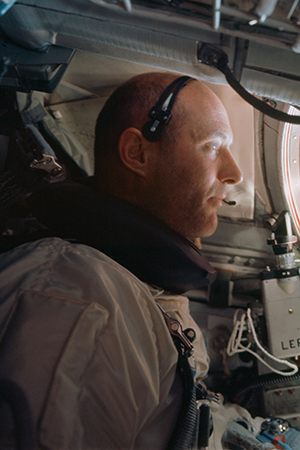
Gemini 9A command pilot Thomas Stafford is photographed during the 1966 mission by pilot Gene Cernan. (NASA)
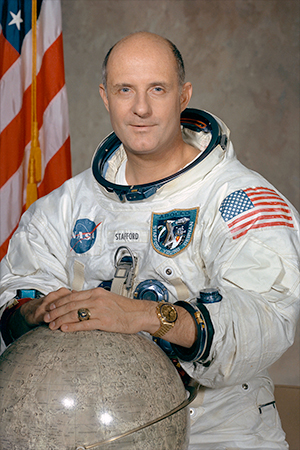
NASA portrait of Apollo 10 commander Thomas Stafford. (NASA)
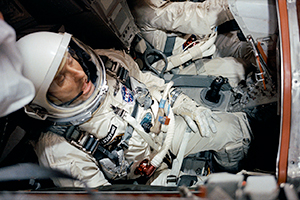
Thomas Stafford is pictured in the Gemini 6A spacecraft while atop Pad 19 prior to the hatches being closed for launch. (NASA)
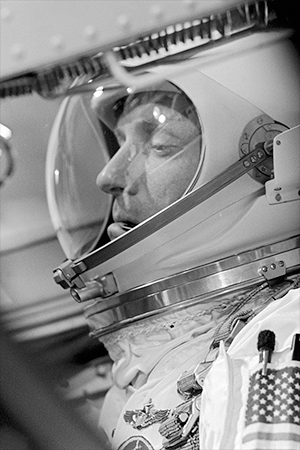
Gemini 6A pilot Thomas Stafford is seen through the hatch window as he awaits the remaining minutes of the countdown. (NASA)
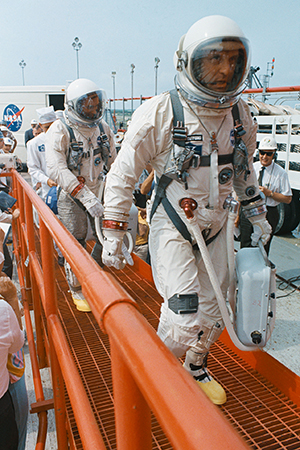
Gemini 9A command pilot Thomas Stafford and pilot Gene Cernan walk up to Pad 19 during a practice countdown. (NASA)
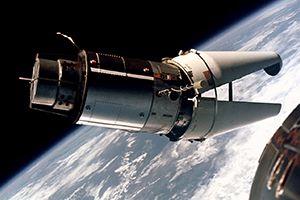
The "angry alligator" or Augmented Target Docking Adapter (ATDA) as seen by the Gemini 9A crew during a rendezvous. (NASA)
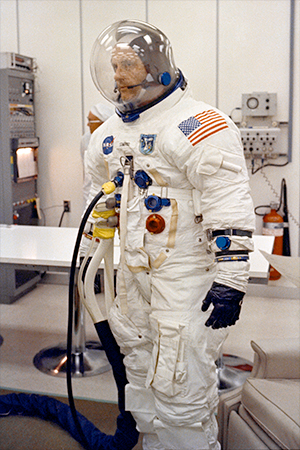
Apollo 10 commander Tom Stafford is suited up for a countdown demo test during preparations for the lunar orbit mission. (NASA)
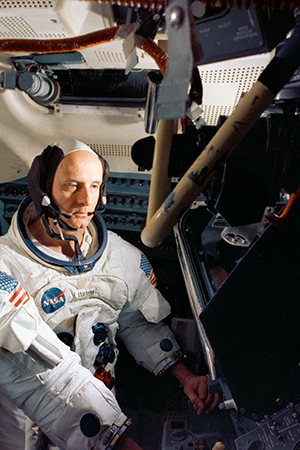
Thomas Stafford and Gene Cernan participate in simulation activity during preparations for the Apollo 10 lunar orbit mission. (NASA)
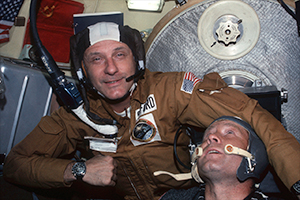
Thomas Stafford and Alexei Leonov are photographed together during the joint Apollo-Soyuz Test Project in Earth orbit. (NASA)
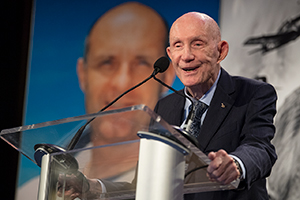
Thomas Stafford speaks after receiving the General James E. Hill Lifetime Achievement Award in 2019. (NASA/Aubrey Gemignani) |
|

© collectSPACE. All rights reserved.
|
|

|

|
